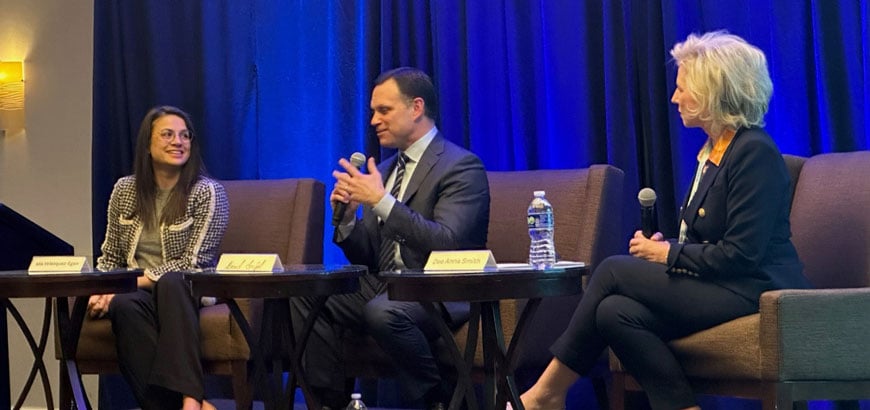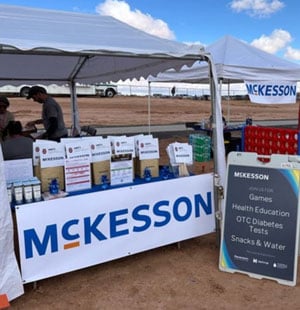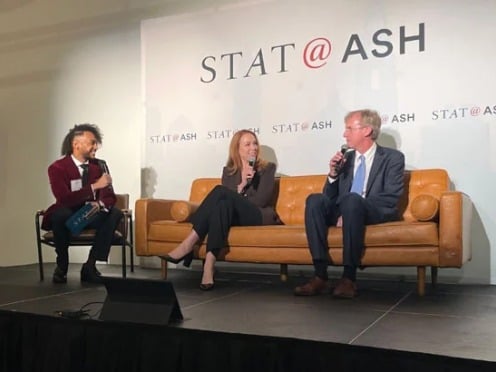
Top insights from the Endpoints at ASCO McKesson leadership panel

Guided by our values, we are an impact-driven organization that improves care in every setting – one product, one partner, one patient at a time.
Through our core commitments, we are leveraging our scale for the greater good, such as serving the needs of our stakeholders, donating back to our communities, protecting our planet, working with policymakers, and more.
Every year, we publish updates to our commitments through our Impact Report.
Download Our Impact ReportOur businesses bring together leading technologies, innovative solutions and hands-on expertise to support the entire healthcare ecosystem.
We distribute pharmaceuticals and medical supplies to healthcare settings across North America, from pharmacies and hospitals to doctors’ offices and clinics.
We help to ensure the financial wellbeing of pharmacies and health systems and support a stable work environment for their employees.
We provide research, insights, technologies and other support to help address challenges in cancer and specialty care.
We provide a suite of solutions designed to address access, affordability and adherence challenges by bridging the gaps between biopharma companies, pharmacies, providers, and payers to help patients get on and stay on their medications.
We offer solutions that enable employers, payers, health-plan brokers and government agencies to provide lower-cost options for prescription medications and therapies.
We help to ensure the financial wellbeing of pharmacies and health systems and support a stable work environment for their employees.
Every year, we publish updates to our commitments through our Impact Report.
Download Our Impact ReportThe US Oncology Network embraces value-based care.

Read time: 4.5 minutes
In the traditional healthcare payment model, a patient visits a provider who then bills for the specific services rendered. Each additional service—perhaps another checkup, scan, or infusion—results in another itemized bill being generated. While this fee-for-service model might seem logical enough, it may result in more tests and other billable services with limited value instead of emphasizing what really matters most: providing patients with the best possible care.
“Historically, we’ve lived in a fee-for-service world, but all the major payers desire fee-for-value,” says Lalan Wilfong, MD, vice president of payer relations and practice transformation for The US Oncology Network (“The Network”), an association of independent oncology practices that is supported by McKesson. With this newer approach, providers focus on providing better value for patients with reimbursement for enhanced patient care.
So-called value-based care isn’t a totally new concept to members of The Network, which has long been helping providers deliver value-based, integrated cancer care for more than a decade. And 14 practices in The Network have been participating in the Oncology Care Model (OCM), a pilot program formed in 2016 that was designed by the Centers for Medicare & Medicaid Innovation to provide higher quality, more coordinated cancer care for the same or lower cost.
Practices that have joined the OCM program commit to several core “redesign” activities aimed at improving care while providing optimal patient experience. Upon joining the OCM program, participating practices reflected on their existing protocols and modified them as needed with an eye on closing gaps necessary to improve patient outcomes. They also agreed to provide 24/7 access to care, expand patient navigation tools and follow nationally recognized clinical guidelines for cancer treatment.
“Oncology is complex because you’re dealing with high-risk patients who need prompt, quality care,” says Stuart Staggs, senior director of strategic programs for The Network. “That’s why it is important to eliminate any barriers that might get in the way of treating a patient, which in many ways is at the heart of any value-based care model.”
One example of a simple change made that had significant impact was the expansion of the “call us first” program. In the past, patients with cancer who felt ill after-hours were generally advised to go to the emergency room, which was difficult for patients and expensive. Since joining the OCM, providers advised patients to contact them first, no matter the day or time.
“The goal was to manage a patient’s urgent care issues in the practice when appropriate rather than send them to the ER,” says Staggs. “Clinicians also reached out to patients more proactively. We wanted to catch problems before they became more acute and try to decrease avoidable hospitalizations.”
Practices also began integrating services such as mental health, social work, navigation, and nutrition counseling for cancer into their offices, rather than referring patients to outside providers.
Meanwhile, employees at each oncology practice clarified their own roles to optimize workflows and make sure that nothing was falling through the cracks. “Pre OCM, physicians would educate patients in the manner in which they saw fit. Some were giving out paperwork about diagnosis and treatment options, whereas some were delegating to advanced practice providers or nurses,” says Dr. Wilfong.
Under the OCM, roles were solidified: The oncologists took charge of discussing treatment options with patients, a crucial part of shared decision making. Once a treatment plan was in place, pharmacists provided instruction on at-home drug administration while nurses and advanced practice providers educated patients on medication side effects, infusion timing, and quality of life. Financial counselors provided any necessary guidance related to financial obligations, and administrative staff made a concerted effort to minimize appointment wait times. Some of these things were happening before, but “we clarified who does what so that patients would have a more uniform experience,” says Dr. Wilfong.
Also crucial: ensuring that patients and doctors were on the same page so that patients felt well-informed about their choices and knew what to realistically expect from their treatment. “Value doesn’t mean cheap or even low cost,” says Dr. Wilfong. “To me, value-based care is about aligning treatment with patient goals,” which entails providing the best treatment for the patient at the lowest cost” in terms of toxicity as well as price.
There’s little doubt that such changes benefitted patients. By December 2020, four and a half years into the OCM, participating practices reported an average 37% decrease in patient hospitalizations and a 24% decrease in emergency department visits. Pain management scores and rates of depression screening also improved.
What’s more, these and other improved metrics translated to a $240 million cumulative savings to Medicare to date while enabling 11 of the 14 practices to receive performance-based payments, thanks to meeting OCM quality and cost goals. Performance-based payments reward practitioners for meeting specific pre-determined goals.
Perhaps most importantly, says Dr. Wilfong, is that patient feedback has been excellent. “We were able to reduce hospitalization and emergency department visits and save money, and patient satisfaction remained high. All in all, we drove value back to our patients.”
The first phase of this OCM program officially ends this summer, and what happens next will be up to the Centers for Medicare & Medicaid Innovation. “They will likely be launching another model and though we don’t yet know the specifics, we can maintain a state of preparedness by continuing to implement much of what we learned,” says Dr. Wilfong. “Patients appreciate the changes this model has driven. They now expect to have shared-decision making and enhanced services provided to them.”

Top insights from the Endpoints at ASCO McKesson leadership panel

Insights and Takeaways for The Next Chapter in Specialty Medicine from Asembia AXS25

Enhancing patient access and engagement in clinical trials.

Learn how InspiroGene is helping deliver revolutionary cell and gene therapies to patients in need.

Insights from the 2025 CoverMyMeds Medication Access Report, From Barriers to Bridges

Learn about the crucial role Sarah Cannon Research Institute (SCRI) played in helping a patient overcome prostate cancer.

For two years in a row, McKesson has partnered with customers and industry partners to bring health education and awareness of resources to members of the Navajo community.

Learn more about RxOwnership, McKesson’s strategic consultants who help independent pharmacy owners navigate challenges, optimize operations and achieve financial health.

During the recent STAT @ ASH event in San Diego, panelists explored the role of community oncology in advancing precision medicine for cancer care.

Learn about McKesson’s new Cell and Gene Therapy (CGT) brand, InspiroGene, and the launch of a first-of-its-kind report about the CGT landscape and its future trajectory.